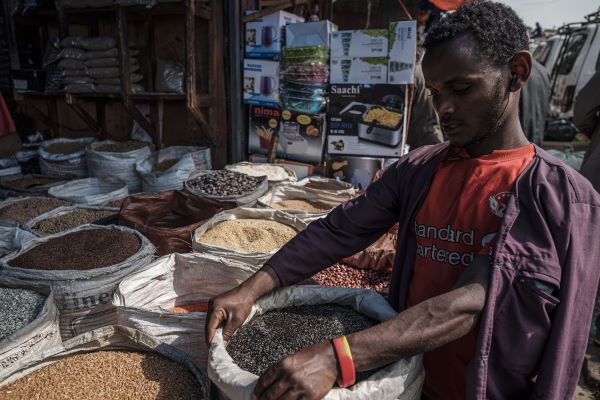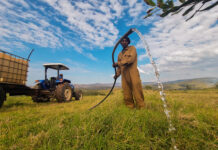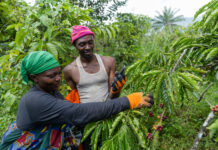Joint Op-ed by: Chimimba David Phiri, FAO Subregional Coordinator & Representative to the AUC and UNECA;Sara Mbago-Bhunu, IFAD Regional Director for East and Southern Africa; and Menghestab Haile,WFP Regional Director for Southern Africa
With hunger worsening considerably since 2019, Africa is not on track to meet the internationally agreed Sustainable Development Goal (SDG2), which aims to ‘end hunger, achieve food security and improved nutrition and promote sustainable agriculture’. An estimated 282 million people were undernourished in the continent in 2022, an increase of nearly 60 million people, just in three years, according to the latest (2023) UN report on the State of Food Security and Nutrition in the World. Figures show that among under-5 children, 59 million suffer from stunting, and 14 million suffer from wasting. Today there are more stunted children than 20 years ago, and Africa is the only region whose stunting figures are on the rising trend.
More than 430 million Africans, primarily residing in rural areas, live in extreme poverty, and an estimated 80 per cent of the population cannot afford a healthy diet. Unstable and increasing food prices, spurred on by the effects of climate change, Covid-19 and the war in Ukraine, are pushing more people into chronic hunger and malnutrition.
The problem of malnutrition costs economies a significant amount of resources due to higher healthcare costs, poor education performance and loss of productivity. The Cost of Hunger in Africa 2022 Report states that 7 to 16 per cent of repetitions in school are associated with stunting, and stunted children achieve 0.2 years to 1.2 years less in school education. The economic impact associated with child malnutrition, particularly underweight and stunting, ranges between 3 and 16% of GDP annually.
Globally, as malnutrition has increased, so have the estimated nutrition-specific financing needs – from US$7 billion per year to nearly US$11 billion per year over 2022–2030 (based on an estimated total of US$97 billion).
We must therefore invest in nutrition because adequate nutrition is at the interface for progress in health, education, employment, empowerment of women and reduction of poverty and inequality, and can lay the foundation for peaceful, secure and stable societies. Unfortunately, current investments are not comparable to the scale of the nutrition problem. This fact is reflected in the ‘2020 Global Nutrition Report‘, which observes that among 48 low-income countries, average government spending on ‘nutritional deficiencies’ is just $1.87 per person, representing the lowest expenditure for any disease category tracked.
Advancing progress against malnutrition will require deliberate and sustainable investment in nutrition and nutrition-sensitive agrifood systems. There is a significant return on investment for countries with proper nutrition financing mechanisms. Studies show that every $1 invested in nutrition can generate $16 in returns. Reducing malnutrition could increase national overall economic productivity by 11 per cent, as measured by GDP per capita. For example, for 15 African countries, meeting the 2025 World Health Assembly target for stunting would add $83 billion to national incomes.
In response to decades of underinvestment that has led to slow and uneven progress against malnutrition, United Nations agencies and development partners are making concrete progress in driving, promoting and creating awareness on nutrition financing. The 2022 African Union Year on Nutrition under the theme “Strengthening Resilience in Nutrition and Food Security on the African Continent: Strengthening Agro-Food Systems, Health and Social Protection Systems for the Acceleration of Human, Social and Economic Capital Development” helped to reinforce political commitments and spurred increased awareness of the need to address malnutrition in all its forms.
In December 2022, African leaders endorsed the Abidjan Declaration, which calls for ‘accelerated investment, implementation, and coordination to improve nutrition and food security in Africa.’ African governments and their partners further committed to increased funding for nutrition during the High-level Conference on Nutrition Financing, hosted by King Letsie III, in Maseru, to prioritize nutrition investment to accelerate Africa’s economic transformation. Furthermore, the Africa Food Summit /Dakar 2 endorsed the Country Food and Agriculture Delivery Compacts as a means to accelerate the implementation of the African Union’s Comprehensive Africa Agriculture Development Programme (CAADP)” and called for internal and external financing from a broad range of bilateral and multilateral partners, and the private sector.
A holistic approach towards improving nutrition financing in Africa
A holistic approach must be adopted where different actors should each play a role in driving this agenda. All countries and international organizations must continue to include nutrition as a priority in development finance and fulfil their commitments made at global conferences such as the First and Second International Conferences on Nutrition, the First International Conference on Food Safety, the UN Food Systems Summit, Nutrition for Growth (N4G) Summit, and others.
Low and middle-income countries with a high burden of malnutrition should strive to increase the share of their national budgets allocated for nutrition, while exploring new mechanisms for embedding nutrition within national programmes, for example universal health coverage, social protection, climate financing and food systems financing.
Nutrition-sensitive development investments are also essential to complement and support direct nutrition initiatives. Investments in natural resources, agriculture, food systems, trade and commerce are essential to improve the availability (variety, diversity and quality), accessibility (market and value chain), affordability (price and income), and preparation and consumption (nutrition knowledge) of nutritious foods. These investments may come from international financing institutions, international organizations, multilateral agencies and public resources at the country level, and even from farmers and the private sector.
Strategies to respond to climate change through adaptation and mitigation should also take into account the impact of climate change on nutrition and explicitly address nutrition in the climate financing agenda.
Consistent domestic financing offers a long-term solution for achieving sustaining gains. Doing so requires explicitly considering nutrition in investments and costing of the required financing. In this regard, Members of Parliament (MPs) bear critical responsibilities in ensuring adequate budgets for nutrition. MPs should advocate for, and approve, budgets that are in line with the African Union’s Maputo and Malabo Declarations to strengthen agrifood systems that support healthy diets and improved nutrition.
Meanwhile, donor countries should fulfil their commitments to nutrition and increase the budget needed to implement nutrition-relevant actions in development programmes, such as health, agriculture, education, environment and humanitarian programmes.
Regional Economic Communities and other development actors can work towards enhancing value-for-money and the absorptive capacity for nutrition budgets. Better data and budget tracking are crucial to facilitate smart investment decisions, and ensure accountability.
Exploring and adopting innovative financing mechanisms to channel new resources and fill the investment gap in nutrition, including through Public-Private Partnerships, risk management tools, innovative credit tools and smart subsidies, migrant remittances, social bonds, climate-related financing, and diaspora investments are crucial.
Private investment in nutrition programmes should be encouraged. Agriculture itself is largely a private sector endeavour that includes private sector players along the value chain, such as agriculture input providers, food producers, traders, processors, transporters, wholesalers or retailers. Along the value chain, there are opportunities for engaging with private sector actors to improve nutrition outcomes. These range from increasing productivity through improved inputs (such as fertilizer, high-yielding and highly nutritious varieties, drought and pest-resistant crops); better access to finance, improved irrigation (water pumps and drip systems), improving postharvest practices for reducing the quantity and nutritional quality (storage, processing/preservation, food safety and handling); fortifying staple foods; and improved food distribution and transport.
The private sector can also be involved in messaging for better nutrition, women’s economic empowerment and promoting healthy diets. The private sector can also invest in research and development of new nutritious products, introduction of innovative technologies and further support food fortification programmes to improve nutrition outcomes. Civil society organizations can play a part in promoting comprehensive and cost-efficient nutrition-sensitive social protection systems.
Fragmented food markets present a significant challenge in the distribution of nutritious food. Unhealthy food options such as fast food, cheap processed foods, and calorie-dense products high in sugar, unhealthy fats, and salt dominate fragmented markets. This not only compromises food quality but also raises safety concerns. It is crucial to incentivize food producers to prioritize the production and distribution of nutritious foods through subsidies, grants, and tax breaks to offset the costs associated with producing and distributing healthier options, making them more affordable and accessible to consumers.
Offering technical training and capacity-building programmes to food producers is another way to incentivize them and promote the distribution of healthy diets. Educating producers on the importance of nutrition and providing them with the knowledge and skills necessary to produce nutritious and healthy foods can actively contribute to improving food quality and addressing nutritional deficiencies in the market.
Finally, there should be deliberate actions to promote investment in implementing sustainable climate-resilient and nutrition-sensitive agrifood systems to improve returns on investment and retain gains made.
FAO, IFAD and WFP, by working together among themselves, and with their respective and common partners, are supporting the call of King Letsie III and other African Heads of State to increase sustainable funding for nutrition in Africa.









[…] Source link […]
Comments are closed.